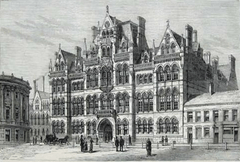Arthur Lapworth
Arthur Lapworth FRS[1] (10 October 1872 – 5 April 1941) was a Scottish chemist.
He was born in Galashiels, Scotland, the son of geologist Charles Lapworth and educated at St Andrew's and King Edward's School, Birmingham. He graduated in Chemistry from Mason College (later Birmingham University). From 1893 to 1895 he worked on a scholarship at City and Guilds of London Institute on the chemistry of camphor and the 3 mechanism of aromatic substitution.[1]
His first post (in 1895) was as a Demonstrator in the School of Pharmacy, University of London in Bloomsbury. From there he went to the Goldsmiths Institute as head of the Chemistry Department and in 1909 became Senior Lecturer in Inorganic and Physical chemistry at the University of Manchester. In 1913 he was appointed Professor of Organic Chemistry and in 1922 the Sir Samuel Hall professor (of inorganic and physical chemistry) and Director of Laboratories.
He was a pioneer of the field of physical organic chemistry. His proposal for the reaction mechanism for the benzoin condensation is the basis for our modern-day understanding of organic chemistry.[2][3][4]
He was elected a Fellow of the Royal Society in May 1910,[1] and was awarded their Davy Medal in 1931.[5]
He married Kathleen Holland, whose brothers were eminent scientists themselves, in 1900. (Frederick Stanley Kipping and William Henry Perkin, Jr.). He retired in 1935 and died in Manchester.
References
- Robinson, R. (1947). "Arthur Lapworth. 1872-1941". Obituary Notices of Fellows of the Royal Society. 5 (15): 554–572. doi:10.1098/rsbm.1947.0018.
- Saltzman, M. (1972). "Arthur Lapworth. The genesis of reaction mechanism". Journal of Chemical Education. 49 (11): 750. doi:10.1021/ed049p750.
- Lapworth, A. (1903). "XCVI.—Reactions involving the addition of hydrogen cyanide to carbon compounds". Journal of the Chemical Society, Transactions. 83: 995. doi:10.1039/CT9038300995.
- Lapworth, A. (1904). "CXXII.—Reactions involving the addition of hydrogen cyanide to carbon compounds. Part II. Cyanohydrins regarded as complex acids". Journal of the Chemical Society, Transactions. 85: 1206–1214. doi:10.1039/CT9048501206.
- "Library and Archive Catalogue". Royal Society. Retrieved 7 November 2010.
